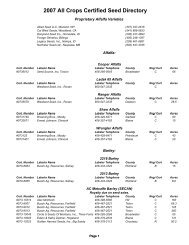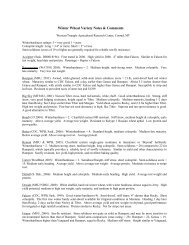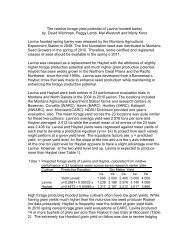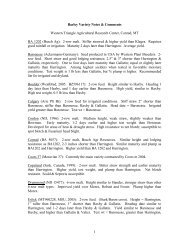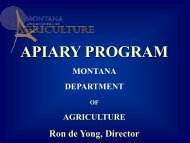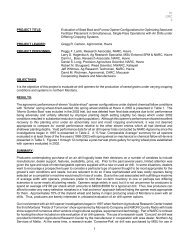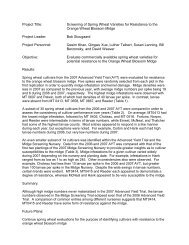Fall 2012 - College of Agriculture - Montana State University
Fall 2012 - College of Agriculture - Montana State University
Fall 2012 - College of Agriculture - Montana State University
Create successful ePaper yourself
Turn your PDF publications into a flip-book with our unique Google optimized e-Paper software.
<strong>Montana</strong> <strong>State</strong> <strong>University</strong> <strong>College</strong> <strong>of</strong> <strong>Agriculture</strong> <strong>Fall</strong> <strong>2012</strong><br />
Inside:<br />
<strong>Montana</strong> Fires and their Impact<br />
Invasive Weeds: A Disturbance<br />
in and <strong>of</strong> themselves<br />
Bugs can be Disturbing<br />
dis•tur•bance<br />
Disturbance<br />
noun The interruption <strong>of</strong> a settled and<br />
peaceful place.<br />
origin Middle English: from Old French<br />
destourbance, from destourber
It’s hot. It’s dry. And<br />
there doesn’t seem<br />
to be a break on the<br />
way. It seems every<br />
year we are faced with<br />
either too much or too<br />
little water, and it has<br />
certainly been that way<br />
this year. In this issue<br />
<strong>of</strong> Linked to <strong>Agriculture</strong><br />
we wanted to share<br />
with you some <strong>of</strong> the<br />
“disturbances” that<br />
impact our <strong>College</strong> and<br />
how researchers strive to minimize the impact that natural<br />
disturbances such as fires, drought, or even too much water, can<br />
have on the agricultural industry and natural resources. We also<br />
wanted to share with you some examples <strong>of</strong> financial and other<br />
“disturbances” that sometimes impact our students and faculty<br />
and how alumni support <strong>of</strong>ten mitigates those issues. I hope you<br />
enjoy this edition as we explore how the <strong>College</strong> <strong>of</strong> <strong>Agriculture</strong><br />
deals positively with challenges that affect the state and beyond<br />
and turns those disturbances into learning and research<br />
opportunities. We look forward to feedback and ideas from our<br />
readers. If there is something you would like to see included in<br />
our upcoming editions <strong>of</strong> the newsletter, please don’t hesitate to<br />
share your thoughts with us at agdean@montana.edu.<br />
Jeff Jacobsen<br />
Dean and Director<br />
<strong>College</strong> <strong>of</strong> <strong>Agriculture</strong><br />
<strong>Montana</strong> Agricultural Experiment Station<br />
Celebrate <strong>Agriculture</strong>!!<br />
October 26 – 27<br />
<strong>Montana</strong> <strong>State</strong> <strong>University</strong>’s <strong>College</strong> <strong>of</strong> <strong>Agriculture</strong> is<br />
seeking nominations for outstanding agricultural leaders<br />
to honor during <strong>2012</strong> Celebrate <strong>Agriculture</strong>!! Oct. 26–27.<br />
The name was changed to reflect the significant role<br />
agriculture has at MSU and throughout <strong>Montana</strong>.<br />
“Celebrate <strong>Agriculture</strong>!! is all about sharing ideas and<br />
generating relationships in a festive atmosphere,” said<br />
Jeff Jacobsen, dean <strong>of</strong> the <strong>College</strong> <strong>of</strong> <strong>Agriculture</strong> and<br />
director <strong>of</strong> the <strong>Montana</strong> <strong>Agriculture</strong> Experiment<br />
Station. The venue <strong>of</strong>fers the <strong>College</strong> <strong>of</strong> <strong>Agriculture</strong> the<br />
right opportunity to present the annual Outstanding<br />
Agricultural Leader(s) awards to those who have exhibited<br />
leadership in <strong>Montana</strong> public service, as an agricultural<br />
producer, industry advocate, agri-business leader or as a<br />
friend <strong>of</strong> agriculture.<br />
Successful award applicants will be:<br />
• well respected in their agricultural community,<br />
• actively involved in the agriculture industry with<br />
accomplishments that impact many, and<br />
• industry leaders; upcoming, active and innovative<br />
producers; or have lifetime achievements in agriculture.<br />
The deadline for nominations is Sept. 15. Download<br />
nomination forms at: http://ag.montana.edu/<br />
development/nomination.pdf. Visit http://ag.montana.edu<br />
for an event schedule.<br />
<strong>Agriculture</strong> <strong>2012</strong>:<br />
A Changing Landscape Conference<br />
The Department <strong>of</strong> Agricultural Economics & Economics<br />
and MSU Extension are hosting <strong>Agriculture</strong> <strong>2012</strong>: A<br />
Changing Landscape conference October 26 as part <strong>of</strong><br />
MSU’s Celebrate <strong>Agriculture</strong>!! event. The conference will<br />
focus on current issues facing <strong>Montana</strong> agriculture.<br />
For more information or to register, please visit:<br />
www.ampc.montana.edu/fallconference.html<br />
Kelly Gorham<br />
2<br />
MSU Friday<br />
The MSU Friday visit program will be October 19,<br />
<strong>2012</strong>, February 1, 2013 and March 22, 2013. The<br />
program is free and open to all prospective students and<br />
families. MSU Friday is an all-day, on-campus program<br />
<strong>of</strong>fering an in-depth preview <strong>of</strong> college life. Prospective<br />
students and families can meet with faculty and students,<br />
explore academic facilities, tour campus and investigate<br />
possibilities for financial aid and scholarships. Find out<br />
more and register at www.montana.edu/admissions/<br />
msufridayreg.shtml
Weeds and Disturbances<br />
Invasive Weeds: A Disturbance in and <strong>of</strong> themselves<br />
Invasive weeds are one <strong>of</strong> the greatest<br />
threats to rangeland health and can be<br />
viewed as both a disturbance and an<br />
outcome <strong>of</strong> disturbance. Even controlling<br />
weeds can be a disturbance as it opens<br />
space in the plant community for<br />
something else to grow. The ecological<br />
impacts <strong>of</strong> rangeland weeds are complex,<br />
but it is believed weeds alter the structure,<br />
organization and function <strong>of</strong> rangeland<br />
plant communities by threatening<br />
biodiversity and displacing native plants,<br />
hence impacting wildlife and livestock.<br />
Disturbances like fire, overgrazing and<br />
drought <strong>of</strong>ten result in an increase in<br />
weeds. Following a disturbance, weed<br />
management should focus on promptly<br />
containing existing populations, restoring<br />
rangeland severely degraded by weeds,<br />
and preventing establishment <strong>of</strong> new<br />
invaders in noninfested rangeland. Jane<br />
Mangold, assistant pr<strong>of</strong>essor with the<br />
Department <strong>of</strong> Land Resources and<br />
Environmental Sciences, suggests several<br />
ways <strong>of</strong> controlling weed spread after a<br />
disturbance. “Chemical, mechanical, and<br />
biological control; prescribed fire and<br />
deliberate revegetation are all critical for<br />
ecologically- and economically-sound weed<br />
management on rangeland in <strong>Montana</strong>,”<br />
advised Mangold.<br />
Following weed control or other<br />
disturbances, niches are opened in the<br />
plant community. If desirable species are<br />
not present to reoccupy the site, weeds<br />
are likely to reestablish. Planting desirable<br />
species can minimize the problem. However,<br />
revegetation is challenging and <strong>of</strong>ten results<br />
in weedy plants remaining dominant.<br />
Climatic conditions, competition between<br />
seedlings <strong>of</strong> seeded species and weeds,<br />
and thresholds for determining when<br />
revegetation is necessary are all challenges to<br />
successful revegetation. Mangold’s research<br />
focuses on developing integrated methods<br />
for managing rangeland weeds, with special<br />
emphasis on revegetation. Results from<br />
the research will help rangeland recovery<br />
following disturbances.<br />
A recent comparative study between<br />
cheatgrass and the native bluebunch<br />
wheatgrass suggested bluebunch wheatgrass<br />
seedlings avoid suppression by cheatgrass<br />
more effectively when they are larger at<br />
the time <strong>of</strong> cheatgrass seedling emergence.<br />
Larger bluebunch wheatgrass seedlings can<br />
more effectively suppress cheatgrass, but soil<br />
nitrogen enrichment decreases the ability <strong>of</strong><br />
bluebunch wheatgrass to do so. According<br />
to Mangold, management practices that<br />
encourage perennial grasses to emerge<br />
before cheatgrass could improve seedling<br />
establishment in revegetation projects.<br />
Results <strong>of</strong> Mangold’s research also suggest<br />
competition between bluebunch wheatgrass<br />
and cheatgrass may be altered to favor<br />
cheatgrass when plant-available N is<br />
increased, a condition <strong>of</strong>ten created by<br />
disturbance. “Based on past revegetation<br />
projects don’t expect immediate success,”<br />
said Mangold. “It takes time for the plant<br />
communities to recover from disturbances.” <br />
Jane Mangold in a field. Photo taken by Rick Engel.<br />
3
Erin Longergan, a graduate student<br />
in PSPP, planted whitebark seedlings<br />
at the MSU greenhouse as part <strong>of</strong> the<br />
study. Longergan is currently studying<br />
how fertilizer affects mycorrhizal colonization<br />
<strong>of</strong> pine roots in the greenhouse.<br />
Blister Rust and Fire Suppression<br />
Disturb the White Bark Pine<br />
Whitebark pine (Pinus albicaulis) is a<br />
threatened species which grows at treeline<br />
in <strong>Montana</strong> and surrounding areas. The<br />
pine is important in watershed dynamics<br />
and the seeds are a valuable food source<br />
for grizzly bears. It is in decline due to<br />
whitebark pine blister rust, mountain pine<br />
beetles and fire suppression.<br />
The USDA Forest Service and the National<br />
Parks are trying to plant new rust resistant<br />
nursery seedlings and reestablish whitebark<br />
pine forests. Assisting their efforts<br />
is Cathy Cripps, associate pr<strong>of</strong>essor with<br />
the Plant Sciences and Plant Pathology<br />
Department. Cripps is leading a research<br />
team examining fungi in extreme<br />
environments including whitebark pine<br />
forestlands and alpine tundra. In previous<br />
research, the team identified native ectomycorrhizal<br />
fungi which are important to<br />
growing whitebark pine. Cripps has been<br />
working to identify these fungi, maintain<br />
them in the lab and use them for inoculation<br />
<strong>of</strong> rust resistant nursery stock in the<br />
greenhouse. “Adding the ‘good fungi’ to<br />
nursery crops will help the Forest Service<br />
re-establish the whitepine bark in parks<br />
in Alberta, Canada, <strong>Montana</strong> and Idaho,”<br />
said Cripps who has done extensive<br />
research in both Yellowstone and Glacier<br />
National Parks.<br />
In the wild, tree roots are naturally covered<br />
with fungi. In nurseries those fungi<br />
are controlled and the new plants struggle.<br />
While fungi are sometimes considered a<br />
disturbance, it is important to recognize<br />
that there are good and bad fungi just<br />
as there are good and bad disturbances,<br />
added Cripps. <br />
4
Bugs can be Disturbing<br />
Walking into the quarantine lab in the<br />
MSU Plant Growth Center is a bit like<br />
walking onto the set <strong>of</strong> a science fiction<br />
movie. And then to be left alone in a<br />
glass-sided room with unknown creepy<br />
crawling critters climbing about is just plain<br />
disturbing. Annie DeMeij, research assistant<br />
for the Department <strong>of</strong> Land Resources and<br />
Environmental Sciences, is not bothered by<br />
them at all. In fact she raises them — nurtures<br />
the eggs, transfers larvae, cheers on the<br />
growing pupae and even brags about the<br />
young adults that emerge a few months later.<br />
DeMeij is working with Jeffrey Littlefield,<br />
a research scientist in LRES, improving<br />
and developing new ways <strong>of</strong> using insects<br />
to control noxious weeds. Littlefield and<br />
DeMeij are rearing colonies <strong>of</strong> insects to<br />
attack harmful weeds in <strong>Montana</strong>. Current<br />
research projects are investigating new<br />
biological control agents for:<br />
• Russian knapweed<br />
• hoary cress<br />
• invasive hawkweeds, and<br />
• rush skeletonweed<br />
Invasive plant species are a serious<br />
economic and ecological problem for range<br />
and forested lands. “Noxious weeds impact<br />
productivity and the invaders compromise<br />
the ecological integrity <strong>of</strong> <strong>Montana</strong>’s land,”<br />
stated Littlefield. These projects contribute<br />
to the selection <strong>of</strong> potentially new control<br />
agents and increase knowledge about how<br />
to use them.<br />
Scientists introduced three new insects into<br />
<strong>Montana</strong> for controlling Russian knapweed<br />
and orange hawkweed. One <strong>of</strong> these is a<br />
small fly that only lives a few days. “The gall<br />
midge (Jaapiella ivannikovi) lays its eggs on<br />
the knapweed’s tip which keeps the plant<br />
from flowering and seeding,” explained<br />
DeMeij as she pointed at the rounded<br />
green “gall” at the plant’s top. The small<br />
insect causes the plant to grow a gall — an<br />
abnormal outgrowth <strong>of</strong> plant tissue — creating<br />
a cocoon-like environment for the larvae<br />
and keeps the weed from seeding.<br />
Littlefield also rears two stem galling<br />
wasps for controlling the weeds. One gall<br />
wasp attacks the developing stem <strong>of</strong> the<br />
knapweed plant; while the other wasp,<br />
which resembles a tiny flying-ant, stunts the<br />
stolons or runners <strong>of</strong> hawkweed and keeps<br />
it from spreading. In May the research team<br />
used approximately 180 females to rear 800<br />
individuals in the quarantine lab for release<br />
at hawkweed infested sites next year.<br />
Littlefield started the Russian knapweed<br />
project with less than 40 gall wasps from<br />
Uzbekistan and has developed a large<br />
field population — up until this year the<br />
only ones in the U.S. “Because they only<br />
produce one generation per year and are<br />
highly attacked by various parasites, it has<br />
The gall midge on Russian knapweed.<br />
Photo taken by Tanya Reinhardt.<br />
been difficult to release enough wasps to<br />
make a significant impact in a few years,”<br />
stated Littlefield. A measure <strong>of</strong> success is to<br />
compare the total wasps released to the galls<br />
found on Russian knapweed in test sites.<br />
Results on private ranchland near Toston,<br />
Mont., were positive. Researchers released<br />
approximately 20 gall wasps in 2009 and<br />
found an equal number <strong>of</strong> galls infesting the<br />
Russian knapweed. Since then the numbers<br />
have increased exponentially with thousands<br />
<strong>of</strong> galls present this year. “The gall wasp<br />
is holding its own at this test site,” stated<br />
Littlefield. “And it shows great potential as<br />
a control agent for Russian knapweed if this<br />
trend continues.”<br />
Needless to say the work that started in the<br />
quarantine lab is creating a disturbance for<br />
the noxious weeds <strong>of</strong> <strong>Montana</strong> and the U.S.<br />
Maybe those creepy crawling creatures aren’t<br />
all that disturbing to people — just the<br />
noxious weeds. <br />
“The biggest<br />
challenge our<br />
society faces is<br />
to learn to live<br />
with change<br />
and disturbances”<br />
—Clayton Marlow<br />
pr<strong>of</strong>essor <strong>of</strong> Animal & Range Sciences<br />
Battling Locoweed<br />
Dr. Tracy Sterling, pr<strong>of</strong>essor and department head <strong>of</strong> Land Resources<br />
and Environmental Sciences, is examining alkaloid biosynthesis by<br />
the toxic rangeland plant locoweed. Locoweed grows throughout<br />
the western U.S. poisoning cattle and wildlife. A chemical called an<br />
alkaloid makes the plant toxic and is certainly a disturbance to cattle<br />
that consume it. The alkaloid is produced by a fungus which lives in the<br />
plant and can survive to the next generation. Sterling has found that<br />
even though the fungus produces this expensive alkaloid, it does not<br />
appear to <strong>of</strong>fer the plant any protection from herbivores such as cattle<br />
or insects and the plant’s ability to flourish on the range is unaffected.<br />
She is currently seeking to uncover the genes that control this fascinating<br />
relationship. <br />
Alkaloid: A member <strong>of</strong> a large group <strong>of</strong> chemicals made by plants; normally<br />
contain at least one nitrogen atom in a heterocyclic ring.<br />
5
Devon Ragen, a research associate with<br />
the Dept. <strong>of</strong> Animal & Range Sciences,<br />
helped battle the blaze at Red Bluff.<br />
Photo taken by David Baumbauer.<br />
<strong>Montana</strong> Fires<br />
and their Impact on <strong>Agriculture</strong><br />
6<br />
The Red Bluff Research Ranch found itself in a “hot spot”<br />
June 27 as the Bear Trap Fire burned 20 miles northeast <strong>of</strong> Ennis<br />
and charred 2,000 acres <strong>of</strong> rangeland on the ranch. While fighting<br />
the fire was an adrenaline rush for the student volunteers who held<br />
the southern boundary <strong>of</strong> the fire, for others it was a chance to<br />
explore firsthand the impact fire has on rangeland management.<br />
Kellen Marlow, a senior in Range Management and a summer<br />
employee at the Bozeman Agricultural Research and Teaching<br />
(BART) Farm, helped control the southern line <strong>of</strong> the fire and deter<br />
it from hitting any structures at the ranch. As fire crews worked <strong>of</strong>f<br />
in the distance, Kellen discussed what he knew about fire and its<br />
impact on rangeland. “Fire burns the dead material and the invasive<br />
species which allows the range to move back into a successional<br />
stage. As early grasses progress, the first species are replaced by<br />
heartier species — especially at Red Bluff,” he explained.<br />
Kellen Marlow’s knowledge about the benefits <strong>of</strong> fire to rangelands<br />
was passed to him by noted pr<strong>of</strong>essor <strong>of</strong> <strong>Montana</strong> <strong>State</strong> <strong>University</strong>’s<br />
<strong>College</strong> <strong>of</strong> <strong>Agriculture</strong> Clayton Marlow, who also happens to be<br />
Kellen’s father. “My dad teaches a class on fire restoration and how<br />
to use it in agriculture,” added Kellen.<br />
Clayton Marlow, a pr<strong>of</strong>essor in the Department <strong>of</strong> Animal & Range<br />
Sciences, teaches a course on fire ecology and management. Marlow<br />
explains to his students the importance <strong>of</strong> regular disturbances to the<br />
health <strong>of</strong> many western ecosystems. “The biggest challenge our society<br />
faces is to learn to live with change and disturbances,” said Clayton,<br />
citing fire as a prime example. “Fire resets the ecological clock and<br />
Using fire for good:<br />
• Available nitrogen pulse to soil<br />
• Move wildlife populations<br />
• Protect grazers from predators hiding in the thick ground cover<br />
• More water in the creek for grayling and cutthroat<br />
• Protective fires—burn one area to protect another<br />
Negative impact:<br />
• Must replace fence at Red Bluff Ranch<br />
• Lost part <strong>of</strong> the winter pasture which means buying more hay
allows plant and animal species to spring back. It<br />
refreshes the plants and wildlife and makes them<br />
capable <strong>of</strong> withstanding other disturbances.” A<br />
healthy ecosystem leads to more calves, lambs and<br />
better wool in two to four years, but it is going to<br />
be tough for the stockman initially as they try to<br />
find food for the stock, summarized Marlow.<br />
Bob Brekke, the BART Farm animal operations<br />
manager, discussed the positive and negative<br />
impacts <strong>of</strong> the fire. “We lost a lot <strong>of</strong> winter<br />
pasture, which means we have to buy more hay,<br />
but it also burned out weeds and a bunch <strong>of</strong> low<br />
lying brush which increases the ground moisture<br />
available for native grasses,” he stated. Brekke<br />
already sees an immediate economic impact as<br />
they buy hay.<br />
Clayton argues our forest lands have been<br />
weakened because we have controlled too<br />
many disturbances such as flooding and fires.<br />
“Cottonwood growth was stopped when we started<br />
to control flooding. When the flooding was<br />
controlled, the willows and trout also struggled.<br />
We need to be cognizant that disturbances aren’t<br />
always a bad thing,” said Marlow.<br />
A natural bi-product <strong>of</strong> fire is a pulse <strong>of</strong> nitrogen<br />
(N) into the soil, which impacts the competitive<br />
balance <strong>of</strong> invasive and native species. Spotted<br />
knapweed, for example, thrives where fires<br />
are actively suppressed. The fire suppression<br />
allows invaders into the system. Cheatgrass<br />
is an exception, because it actually likes hot<br />
destructive fires and it likes N rich soils.<br />
At Red Bluff the super-heated soil added lots <strong>of</strong><br />
available N to the soil. Some areas already have<br />
native grasses coming back. This fall students<br />
will test N levels and study hydrophobicity (how<br />
soil repels water, which can lead to erosion).<br />
Bunch grasses have already re-sprouted at Red<br />
Bluff, and scientists and pr<strong>of</strong>essors are looking<br />
forward to studying the impact <strong>of</strong> the fire at the<br />
research ranch and extracting knowledge from<br />
the disturbance.<br />
“Listening to Smokey the Bear wasn’t always the<br />
best thing to do,” said Marlow. “We didn’t let<br />
the fires burn; we stopped logging, and now<br />
the fires are really bad. Expect deer, elk and<br />
pronghorns to shift into fire area because it’s<br />
nitrogen rich and the grasses are more digestible<br />
and tender,” he explained. <br />
Luther Talbert spoke at the Post Farm Field Days in June.<br />
Photo by Tanya Reinhardt.<br />
Optimism High<br />
From Luther Talbert’s vantage point, <strong>Montana</strong> is having an ok<br />
year — at least average — with optimism across most <strong>of</strong> the state.<br />
Talbert, pr<strong>of</strong>essor and plant breeding scientist in the Department <strong>of</strong><br />
Plant Sciences & Plant Pathology, developed ‘Vida’ as a drought resistant<br />
variety <strong>of</strong> spring wheat. “We needed spring wheat that performed<br />
with limited water,” explained Talbert. Researchers developed ‘Vida’<br />
with a genetic trait that allows the leaves to stay green for a few more<br />
days under hot dry conditions. The extra green time allows the plants<br />
to undergo photosynthesis longer and better fill the grain.<br />
Talbert is part <strong>of</strong> a nationally funded grant conducting research on<br />
water use efficiency in wheat and barley crops. Other team members<br />
include Tom Blake and Jamie Sherman, both <strong>of</strong> the Plant Sciences &<br />
Plant Pathology Department. The research team is in their second year<br />
<strong>of</strong> a five-year study exploring how to improve wheat and barley in a<br />
changing climate. The $2.3 million dollar grant is part <strong>of</strong> a larger $25<br />
million project. <br />
Silver Lining in a Disturbance<br />
“Even droughts have silver linings,” said Vincent Smith, pr<strong>of</strong>essor<br />
<strong>of</strong> economics in the Department <strong>of</strong> Agricultural Economics &<br />
Economics. The drought in the Midwest is expected to reduce the corn<br />
crop in Iowa, Illinois and Indiana between 20 and 35 percent — the<br />
consequence is a sharp increase in corn prices, which will result in an<br />
increase in wheat prices explained Smith.<br />
Low quality wheat will be a more important food source for livestock,<br />
resulting in higher wheat prices. “Wheat producers in <strong>Montana</strong> with<br />
even an average crop are likely to have a financially successful year,”<br />
Smith added. Consumers, however will likely face higher prices for<br />
staples due to lower feed, food grain and oilseed production. <br />
7
ImID Focusing on Health Disturbances<br />
Research in Immunology & Infectious<br />
Diseases (ImID) focuses on the development<br />
<strong>of</strong> new drugs, vaccines and diagnostic<br />
tools for fighting infectious diseases <strong>of</strong><br />
livestock, humans and wildlife. Jovanka<br />
Voyich-Kane, assistant pr<strong>of</strong>essor, is researching<br />
Staphylococcus aureus — a common<br />
bacterium found on human skin and in<br />
nasal passages. Although this organism can<br />
be a benign inhabitant, it can also cause<br />
skin infections, bacteremia, endocarditis,<br />
sepsis and toxic shock syndrome, according<br />
to Voyich-Kane. “Our lab focuses on how<br />
the bug causes disease in healthy humans.”<br />
“S. aureus is one <strong>of</strong> the most common causes<br />
<strong>of</strong> skin-and s<strong>of</strong>t-tissue infections in the<br />
United <strong>State</strong>s,” said Voyich-Kane. “These<br />
infections are very contagious and painful,<br />
and drug resistant strains are difficult to<br />
effectively treat,” she added.<br />
While the staph bacterium is dangerous for<br />
humans, it also is a problem in livestock.<br />
Voyich-Kane’s research team is investigating<br />
incidence and characteristics <strong>of</strong> S. aureus<br />
in <strong>Montana</strong>’s dairy herds and studying the<br />
antimicrobial potential <strong>of</strong> a chemokine (a<br />
signaling protein) found in bovine milk.<br />
“We want to learn more about immunity to<br />
S. aureus and the prevalence <strong>of</strong> S. aureus in<br />
<strong>Montana</strong>’s dairy herds and also in horses,”<br />
said Voyich-Kane. Staph is one <strong>of</strong> the most<br />
frequent causes <strong>of</strong> mastitis in cattle, which<br />
impacts milk production.<br />
The bacterium can also cause bad infections<br />
in horses. Voyich-Kane’s research team comprised<br />
<strong>of</strong> faculty and students is working<br />
with Dr. Shannon Moreaux, veterinarian<br />
and assistant pr<strong>of</strong>essor in the Department<br />
<strong>of</strong> Animal & Range Sciences. They are<br />
looking at the percentage <strong>of</strong> horses carrying<br />
the bacterium and trying to determine<br />
if they might be a reservoir for S. aureus.<br />
Investigators are surveying several ranches<br />
in the Gallatin Valley and tracking the<br />
presence <strong>of</strong> the bacterium. “We are focusing<br />
on the incidence and transmission potential<br />
<strong>of</strong> S. aureus in <strong>Montana</strong>’s equine populations,<br />
and also looking at the potential for<br />
cross contamination between cattle, horses<br />
and people,” added Voyich-Kane.<br />
ImID is also supporting a project for<br />
junior faculty member Josh Obar. Obar is<br />
investigating the role <strong>of</strong> mast cells in the<br />
progression <strong>of</strong> Listeria infection. Listeria, a<br />
widespread human and animal disease, is<br />
a common cause <strong>of</strong> food borne illnesses.<br />
In ruminants, it can cause encephalitis,<br />
septicemia, late-term abortions and on rare<br />
occasions mastitis. According to current<br />
research data, mast cells may be an important<br />
early source <strong>of</strong> inflammatory cytokines<br />
during heat-killed Listeria infection. <br />
Mast Cells: a certain kind <strong>of</strong> white blood cell<br />
involved in immune and allergy responses.<br />
Market Volatility<br />
Disturbances in agricultural commodity<br />
prices are common, and managing the<br />
volatility is important. Pr<strong>of</strong>essors Gary<br />
Brester and Eric Belasco, Department <strong>of</strong><br />
Agricultural Economics & Economics<br />
faculty, <strong>of</strong>fer senior-level marketing and<br />
management courses to train students in<br />
commodity price risk management —<br />
diversification, forward contracting,<br />
hedging and commodity options.<br />
The <strong>College</strong> and <strong>Montana</strong> businesses<br />
collaborated on the course design. Brent<br />
Poppe, a loan <strong>of</strong>ficer with Stockman Bank,<br />
believed students would learn more with real<br />
money. Stockman Bank, Billings Wells Fargo<br />
Bank and the <strong>Montana</strong> Wheat and Barley<br />
Committee provided funds so classes could<br />
obtain a position in the market. Charley<br />
Switzer, owner <strong>of</strong> Pr<strong>of</strong>essional Commodity<br />
Management in Bozeman, assists the students,<br />
who then monitor and evaluate the portfolio.<br />
Commodity options markets are a way to<br />
manage price risk — a type <strong>of</strong> price insurance,<br />
explained Brester. During the semester,<br />
pr<strong>of</strong>essors <strong>of</strong>fer student teams real world<br />
scenarios: a feedlot manager concerned with<br />
increases in feeder cattle prices or a wheat<br />
producer concerned about price decline.<br />
The class votes as a group to purchase a put<br />
or call option.<br />
Belasco noted the course helps students<br />
learn processes used by producers and<br />
agribusinesses to manage price risk. “It is<br />
an investment in the future, the business<br />
and future employees. They won’t mess up<br />
later — knowing and understanding the risk.<br />
As an employee they are ahead <strong>of</strong> the game.”<br />
Mitch Grove, originally from Highwood,<br />
Mont., graduated from MSU in 2011 with a<br />
double major in economics and agricultural<br />
business, and works as a farm loan <strong>of</strong>ficer for<br />
the <strong>Montana</strong> Farm Service Agency. Grove<br />
recalled his class voting on a speculative<br />
position in the cattle market because they<br />
thought it had the most chance <strong>of</strong> success.<br />
They purchased a “put” option on live cattle.<br />
The Japanese tsunami caused cattle prices<br />
to decline, and they were able to capitalize<br />
on their option much like a cattle processor<br />
would in the same situation.<br />
“(Dr. Brester) made us watch the world<br />
market. One event can throw the market<br />
and cause significant changes. Hedging (the<br />
process <strong>of</strong> purchasing a put option) worked<br />
well for us,” said Grove. “We got little<br />
return after we paid the broker and made<br />
our moves, but the idea wasn’t to speculate<br />
to make money, but rather, to protect our<br />
presumed business from declines in fed<br />
cattle prices.”<br />
Grove helps producers protect themselves<br />
from price declines using futures and options<br />
markets, and credits the classes with helping<br />
him better understand a global economy.<br />
Jessica Lacey, a senior from Folsom, Calif.,<br />
is majoring in Agricultural Business with<br />
a minor in economics, and took the<br />
marketing course from Belasco. Her team<br />
purchased a call option, but feeder cattle<br />
prices declined. “As a speculator we chose<br />
wrong — as a producer it would have been<br />
ok,” said Lacey.<br />
“The spring class purchased a call for $1,600<br />
and basically ended with no value. Losing<br />
was probably a better learning experience<br />
for them,” said Blasco. “Having money<br />
helped keep their interest and demonstrated<br />
the dynamics <strong>of</strong> investor psychologies.” <br />
8
The Wheat Stem Sawfly:<br />
A More Serious<br />
Disturbance<br />
During Dry Years<br />
Photo provided by Bob Peterson.<br />
Researchers at MSU are investigating high<br />
yielding/high quality crop varieties resistant<br />
to insects and diseases that will perform well<br />
in the Northwest region. The agricultural<br />
community and allied industries depend<br />
on new cultivars to remain competitive in<br />
the world marketplace. Primary breeding<br />
objectives include increasing yield potential,<br />
improving winter hardiness, enhancing<br />
wheat stem sawfly resistance and improving<br />
dual-purpose end-use quality grains. MSU’s<br />
research teams will help <strong>Montana</strong> producers<br />
stay competitive and provide improved cultivars<br />
adapted to <strong>Montana</strong>’s ever-changing<br />
climatic conditions and cropping systems.<br />
In addition to worrying about too much<br />
or too little water, growers also continue<br />
to battle the wheat stem sawfly. Pr<strong>of</strong>essor<br />
David Weaver with the Department <strong>of</strong> Land<br />
Resources & Environmental Sciences is developing<br />
new techniques and tools for wheat<br />
stem sawfly management. “<strong>Montana</strong> growers<br />
report they are losing up to $100 million<br />
worth <strong>of</strong> grain per year,” stated Weaver. “The<br />
losses are reported at $350 million per year<br />
in the northern Great Plains <strong>of</strong> the United<br />
<strong>State</strong>s and Canada,” he added.<br />
The wheat stem sawfly problem is exacerbated<br />
by drought because it impairs two <strong>of</strong><br />
the sawfly’s natural enemies — diseases and<br />
parasitic wasps — which thrive in a moister<br />
environment. “Growers should do everything<br />
they can to preserve the parasitic wasp,”<br />
explained Weaver. The wasp kills larvae<br />
in the stem <strong>of</strong> the wheat plant. Growers<br />
provide optimal shelter to the parasitic wasp<br />
by cutting their wheat as high as possible to<br />
allow the overwintering population to be as<br />
large as possible. Other research by LRES<br />
Pr<strong>of</strong>essor Bob Peterson shows that under<br />
certain situations, these parasitic wasps can<br />
kill large numbers <strong>of</strong> immature sawflies, and<br />
the mortality that the wasps cause cannot be<br />
replaced by any other factor.<br />
The winter and spring wheat breeders from<br />
the Department <strong>of</strong> Plant Sciences & Plant<br />
Pathology have collaborated on this project.<br />
Pr<strong>of</strong>essors Luther Talbert and Phil Bruckner<br />
are working to develop strains <strong>of</strong> wheat<br />
that are more resistant to the wheat stem<br />
sawfly. The Northern and Western Triangle<br />
Agricultural Research Centers both have<br />
test sites for the project. Wheat producers<br />
throughout <strong>Montana</strong> are participating in<br />
experiments. Research results indicate the<br />
complex interactions in managing sawfly<br />
make a total systems approach necessary<br />
to reduce damage to small grains. MSU is examining<br />
the integration <strong>of</strong> natural enemies,<br />
pathogens, and plant and insect produced<br />
odors (semiochemical: a generic term for a<br />
chemical substance that carries a message)<br />
for management <strong>of</strong> sawfly and is developing<br />
new sources <strong>of</strong> host-plant resistance. <br />
9
The Disturbed Path:<br />
Students Who<br />
Stop Out<br />
Stop Out: to withdraw temporarily from college.<br />
Several MSU graduate students have tackled<br />
the topic in their thesis work, and while<br />
there’s no singular explanation, we know MSU<br />
students stop out for myriad reasons: family,<br />
personal health and financial instability.<br />
“Anecdotally, I’d argue MSU has always been<br />
a ‘stop out’ friendly institution,” commented<br />
Nora Smith, assistant dean <strong>of</strong> the <strong>College</strong> <strong>of</strong><br />
<strong>Agriculture</strong>. “When we were on the quarter<br />
system, a lot <strong>of</strong> us would take fewer credits<br />
during Winter Quarter. Dozens <strong>of</strong> otherwise<br />
fully-engaged MSU students stopped out<br />
during winter months to work the ski<br />
seasons at Bridger Bowl or Big Sky.”<br />
Since the <strong>Montana</strong> <strong>University</strong> System<br />
restructuring in the 1990s, <strong>Fall</strong> Semester at<br />
MSU <strong>of</strong>ten begins in the middle <strong>of</strong> the busiest<br />
agricultural season — harvest. Many COA students,<br />
who are otherwise working on a family<br />
farm or ranch, juggle multiple demands<br />
during the first few weeks <strong>of</strong> the term.<br />
“There’s a big difference between slowing<br />
down, stopping out and dropping out,”<br />
Smith clarified. In many cases, taking a<br />
semester <strong>of</strong>f can positively impact student<br />
motivation and degree completion.<br />
MSU’s Office <strong>of</strong> Student Success provides<br />
programming, “Return to Learn,” targeting<br />
“stopped out” students in <strong>Montana</strong>,<br />
especially those who might be within a few<br />
semesters <strong>of</strong> finishing their degrees:<br />
www.montana.edu/success/returntolearn.<br />
Student Back After<br />
Stop Out<br />
“I was young and not focused on school.<br />
I needed more discipline,” reminisced<br />
Frank Frontado, a freshman in Animal and<br />
Range Sciences. Originally from Southern<br />
California, Frontado is like many students<br />
who stop out for a number <strong>of</strong> reasons.<br />
Frontado enlisted in the Air Force (AF) as<br />
a parachute-rescue man responsible for<br />
rescuing and treating downed pilots. After<br />
completing his AF tour, he joined Medieval<br />
Times as a knight, where he relied on his<br />
equine experience to joust and participate<br />
in mock fights on horseback at castles<br />
throughout the U.S. and Canada. After<br />
several seasons riding for Medieval Times,<br />
Frontado went back to California as a ranch<br />
hand. It was a roundabout way to return<br />
to school, but this summer after working<br />
on a <strong>Montana</strong> horse ranch near Ennis<br />
and completing farrier school, Frontado<br />
is back — using his GI Bill, experiences<br />
and passion for horses to enhance his<br />
collegiate experience.<br />
“Being a 30-year-old with life experiences<br />
under my belt is a totally different experience,”<br />
stated Frontado. “I love the equine<br />
science program here at MSU. I am excited<br />
about finishing school and getting a good<br />
job in the horse industry,” he added. <br />
Photos: Frank Frontado rode as a Knight during<br />
his Stop Out (top left) and has now come back<br />
as a student in the Department <strong>of</strong> Animal &<br />
Range Sciences (bottom left).<br />
10<br />
Retention Grant<br />
Assists Students in Turbulent Times<br />
The <strong>College</strong> <strong>of</strong> <strong>Agriculture</strong> <strong>of</strong>fers more scholarships per capita than<br />
any other <strong>College</strong> on campus. While most scholarships are based<br />
on academic success and community involvement, some are simply<br />
a boost for students struggling with unforeseen difficulties and<br />
needing immediate assistance. The Christy Retention Grant <strong>of</strong>fers<br />
struggling students immediate financial assistance. Another scholarship<br />
available to students in the Ag Econ department is funded by<br />
a private donor through the MSU Alumni Foundation. “The donor<br />
faced financial hardship in college and is passionate about helping<br />
current students facing adversity,” said Jessica Murdock, student<br />
services coordinator. The Ag Econ Opportunity Scholarship was<br />
awarded to 13 students last year. Murdock looks forward to the<br />
annual scholarship banquet in September. “It is amazing to watch<br />
the students interact with the donors. You can see the impact their<br />
gifts have on the students and the pride they share in their college.<br />
It’s so much more than money…it’s about support,” she added.
“I am a nontraditional student finally<br />
realizing my dream <strong>of</strong> obtaining a degree in<br />
the field <strong>of</strong> natural resources and rangeland<br />
management. I hope to use this degree<br />
to help strike a balance for <strong>Montana</strong>’s<br />
abundant natural resource uses. I grew up<br />
on a cattle ranch northwest <strong>of</strong> Helena, and<br />
know the struggle ranchers and others<br />
have in striking a balance while working<br />
with government agencies, and I hope to<br />
be a part <strong>of</strong> the solution… Thank you for<br />
providing me with this financial gift that<br />
makes it easier to continue my studies<br />
while providing for my family as I balance<br />
school, home and a full-time job.”<br />
Tad Brenden, has a full-time job, is a senior<br />
in Animal and Range Sciences and a<br />
recipient <strong>of</strong> the Christy Retention Grant,<br />
a scholarship that helps students with<br />
immediate financial assistance.<br />
“I am fully aware my accomplishments are<br />
not simply attributed to my hard work and<br />
perseverance. I grew and gained knowledge<br />
only because I found great help from those<br />
like you who gave me loyal support along<br />
the way…Thank you for encouraging me<br />
to reach my goals with financial aid, and<br />
helping me keep my feet from flying out<br />
from under me in this hectic last semester.<br />
The future is looking bright, and I want<br />
you to know how appreciative I am <strong>of</strong> your<br />
support and your contributions to my rather<br />
rosy outlook.”<br />
Photo by Kelly Gorham.<br />
Alix Wittmayer graduated in May with a<br />
degree in agricultural business and was<br />
a past recipient <strong>of</strong> the Christy Retention<br />
Grant. A native <strong>of</strong> Terry, Mont., Wittmayer<br />
is working for the Natural Resource<br />
Conservation Service in Wibaux, Mont.,<br />
as a soil conservationist.<br />
Impact Student Success — Make a Donation<br />
Fellowships, internships and research opportunities directly impact student success through active learning experiences<br />
and can <strong>of</strong>ten only be realized through scholarships due to increasing educational costs. Donations:<br />
• provide access to first-generation students, veterans and their spouses, and create opportunities to distribute need and<br />
merit-based support.<br />
• support student travel to conferences, competitions and compelling exchange programs.<br />
• help the <strong>College</strong> enhance internationally-based curricular experiences.<br />
To make a donation or for more information on how you can assist, please contact Darin Paine, COA development<br />
director at 406-994-7671.<br />
11
<strong>2012</strong>/2013 Events<br />
Sept. 5<br />
Sept. 7<br />
Sept. 7<br />
Sept. 17–22<br />
Oct. 19<br />
Oct. 26–27<br />
Dec. 15<br />
Jan. 8<br />
Feb. 1<br />
Feb. 1<br />
Mar. 22<br />
May 4<br />
<strong>Fall</strong> Convocation<br />
Horticulture Farm Tour<br />
Scholarship Banquet<br />
Homecoming<br />
MSU Friday<br />
Celebrate <strong>Agriculture</strong>!!<br />
<strong>Fall</strong> Commencement<br />
Spring Convocation<br />
Ag Scholarships Due<br />
MSU Friday<br />
MSU Friday<br />
Spring Commencement<br />
Keep up with the <strong>College</strong> <strong>of</strong><br />
<strong>Agriculture</strong> on Facebook. Search for<br />
“<strong>College</strong> <strong>of</strong> <strong>Agriculture</strong>” or “MSU <strong>College</strong><br />
<strong>of</strong> <strong>Agriculture</strong>.”<br />
Military looks to <strong>Montana</strong> Wool<br />
Find out more at http://ag.montana.edu/documents/woolarticle.pdf<br />
MSU Enrollment Hits All-Time High<br />
MSU is facing an all-time enrollment high with enthusiasm and working hard to avoid disturbances<br />
that might accompany a record number <strong>of</strong> students. In a letter to staff and faculty,<br />
Martha Potvin, Provost and Vice President for Academic Affairs, highlighted preparations to<br />
accommodate the influx:<br />
• Hired an additional 120 student tutors with the Smarty Cats Tutoring Program<br />
• Renovated the Writing Center in Wilson Hall<br />
• Added more than 36 sections in high-demand courses<br />
• Modular classrooms added as swing spaces while other classrooms receive technology upgrades<br />
• Freshmen living within 30 miles <strong>of</strong> campus can opt out <strong>of</strong> living on campus<br />
• MSU broke ground on a 70-bed residence building located between the SOB Barn and<br />
North Hedges<br />
Kelly Gorham<br />
Linked to <strong>Agriculture</strong> is published by the MSU <strong>College</strong> <strong>of</strong> <strong>Agriculture</strong>, 202 Linfield Hall, Bozeman, MT 59717; tel: 406-994-3681; fax: 406-994-6579;<br />
email: agdean@montana.edu; http://ag.montana.edu. Cover photo: David Baumbauer; Editor: Tanya Casey-Reinhardt.<br />
<strong>College</strong> <strong>of</strong> <strong>Agriculture</strong><br />
<strong>Montana</strong> <strong>State</strong> <strong>University</strong><br />
202 Linfield Hall<br />
Bozeman, MT 59717<br />
Non-pr<strong>of</strong>it Organization<br />
U.S. Postage<br />
PAID<br />
Permit No. 69<br />
Bozeman, MT 59718<br />
Return Service Requested




